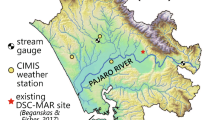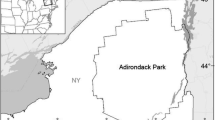Abstract
In karst-rich regions, it is inevitable that roadways cross karst landscapes. Road building across such terranes faces environmental and engineering challenges because of impacts on water quality from stormwater runoff and concerns of sinkhole collapse under or near roadways. When highway runoff drains rapidly into subsurface conduit networks through open sinkholes and/or sinking streams, the impact of the runoff on the karst aquifer can be qualitatively evaluated by mixing cell models. Formulation of a comprehensive stormwater runoff management plan prior to roadway construction can minimize the associated adverse impacts. The commonly used “best management practices” help manage the stormwater runoff effectively in some sites. Site-specific management plans are preferable for other sites because of concerns of flooding and land stability. Proactive measures should be taken to identify areas of the greatest sinkhole collapse risk along the proposed route and the associated groundwater drainage patterns.





Similar content being viewed by others
References
Adams AL, Zhou W, Wang J, Beck BF (2003) Using GPR reflection patterns and NP measurements to predict sinkhole risk in Central Florida. In: Proceedings of 54th Highway Geology Symposium, Burlington, pp 118–127
Beck BF (2004) Soil piping and sinkhole failures. In: Culver DC, White WB (eds) Encyclopedia of caves. Elsevier, Academic, London, pp 521–526
Beck BF, Stephenson JB, Zhou W, Smoot JL, Turpin AM (1996) Design and evaluation of a cost-effective method to improve the water quality of highway runoff prior to discharge into sinkholes. In: Proceedings of Florida Environmental Expo’96. Longwood Environmental Management Inc., pp 155–164
Beck BF, Zhou W (2002) Management of the discharge and quality of highway stormwater runoff in karst areas. Report for Federal Highway Administration under contract DTFH61–93-R-00183. U.S. Department of Transportation
Bradbury KR, Muldoon MA (1992) Hydrogeology and groundwater monitoring of fractured dolomite in the Upper Door Priority Watershed, Door County, Wisconsin. Final report submitted to the Wisconsin Department of Natural Resources by the Wisconsin Geological and Natural History Survey, 74 pp
Brown CJ, Ewers RO (1991) Impacts of barnyard wastes on groundwater nitrate-N concentrations in a maturely karsted carbonate aquifer of South-Central Kentucky. In: Kastning EH, Kastning KM (eds) Appalachian Karst: Proceedings of the Appalachian Karst Symposium. National Speleological Society and Radford University, Radford, 23–26 March, pp 205–210
Currens JC, Graham CDR (1993) Flooding of sinking creek, garretts spring karst drainage basin, Jessamine and Woodford Counties, Kentucky. In: Beck BF (ed) Applied karst geology, Proceedings of the 4th multidisciplinary conference on sinkholes and the engineering and environmental aspects of karst, Panama City, Florida, pp 145–156
Galli J (1990) Peat-sand filters, a proposed stormwater management practice for urbanized areas. Metropolitan Washington Council of Governments, Washington DC
Hyatt JA, Wilkes HP, Jacobs PM (1990) Spatial relationships between new and old sinkholes in covered karst, Albany, Georgia, U.S.A. In: Beck BF, Pettit AJ, Herring GJ (eds) Hydrogeology and engineering geology of sinkholes and karst. A.A. Balkema, Rotterdam, pp 203–218
Hoos AB (1990) Effects of storm-water runoff on local ground-water quality, Clarksville, Tennessee. U.S. Geological Survey, Water-Resources Investigations Report WRI–90–4044, 57 pp
Kastrinos JR, White WB (1986) Seasonal, hydrogeologic, and land-use controls on nitrate contamination of carbonate ground waters. In: Proceedings of the environmental problems in karst terranes and their solutions conference, Bowling Green, Kentucky, 28–30 October. National Water Well Association, pp 88–114
Keith JH, Bassett JL, Duwelius JA (1995) Modification of highway runoff quality by sinkhole drainage structures, Highway 37 improvement project, Lawrence County, Indiana. In: Beck BF (ed) Karst GeoHazards—engineering and environmental problems in karst terrane, Proceedings of the 5th multidisciplinary conference on sinkholes and the engineering and environmental aspects of karst, Gatlinburg, Tennessee. A.A. Balkema, Rotterdam, pp 273–284
Maestri B, Lord BN (1987) Guide for mitigation of highway stormwater runoff pollution: science of the total environment, highway pollution. In: Proceedings of the 2nd international symposium, London, pp 467–476
Martin AD (2004) Case history of the South Street sinkhole, Frederick, Maryland. In: Proceedings of the 55th Annual highway geology symposium, Kansas City, 7–10 September 2004, pp 81–94
Martin E (1988) Effectiveness of an urban runoff detention pond-wetland system. J Environ Eng ASCE 114(4):810–827
Meiman J (1990) Mammoth Cave National Park water quality monitoring program preliminary results of 1990—Year One. In: Karst Hydrology Proceedings of Mammoth Cave National Park’s 1st Annual science conference. U.S. National Park Service, Mammoth Cave National Park, Kentucky, 17–18 December, p 1
Moore HL (2003) Recent sinkhole occurrences along highways in east Tennessee, a historical perspective. In: Proceedings of the 54th Annual highway geology symposium, Vermont, 24–26 September 2003
Moore HL (1996) Planning and designing highways in karst areas. Presentation at the 1996 TDOT transport symposium in Knoxville, Tennessee, April 1–2, 1996
Moore HL (1984) Geotechnical considerations in the location, design, and construction of highways in karst terrain—the Pellissippi Parkway Extension, Knox-Blount Counties, Tennessee. In: Beck BF (ed) Sinkholes: their geology, engineering and environmental impact, Proceedings of the 1st multidisciplinary conference on sinkholes, Orlando, 15–17 October, pp 385–389
Newton JG (1976) Induced sinkholes—a continuing problem along Alabama highways. In: International association of hydrological sciences Proceedings, Anaheim symposium, no. 21, pp 453–463
Nix SJ (1985) Residence time in stormwater detention basin. J Environ Eng ASCE 111(1):95–100
Ogden AE, Hamilton K, Eastburn EP, Brown TL, Pride TE Jr (1991) Nitrate levels in the karst groundwaters of Tennessee. In: Kastning EH, Kastning KM (eds) Appalachian karst: proceedings of the Appalachian karst symposium. National Speleological Society and Radford University, Radford, 23–26 March, pp 197–204
Pride TE, Ogden AE, Harvey MJ, George DB (1988) The effect of urban development on spring water quality in Cookeville, Tennessee. In: Proceedings of the 2nd conference on environmental problems in karst terranes and their solutions, Nashville, Tennessee, 16–18 November. National Water Well Association, pp 97–120
Reeder PP, Crawford NC (1989) Potential groundwater contamination of an urban karst aquifer, Bowling Green, Kentucky. In: Beck BF (ed) Engineering and environmental impacts of sinkholes and karst, Proceedings of the 3rd multidisciplinary conference on sinkholes and the environmental impacts of karst, Orlando, 2–4 October, pp 197–206
Reeder PP, Day MJ (1993) Seasonality of chloride and nitrate contamination in the Southwestern Wisconsin karst. In: Beck BF (ed) Applied karst geology, Proceedings of the 4th multidisciplinary conference on sinkholes and the engineering and environmental aspects of karst, Panama City, pp 53–61
Rothermel SR, Ogden AE (1986) Time-series analysis of Edwards Aquifer springs in Comal County, Texas. In: Proceedings of the environmental problems in karst terranes and their solutions conference, Bowling Green, Kentucky, 28–30 October. National Water Well Association, pp 115–148
Royster DL (1984) Use of sinkholes for drainage. Transportation research record 978, construction and difficult geology: karstic limestone, permafrost, wetlands, and peat deposits, Transportation research council, pp 18–25
Schuster ET, White WB (1971) Seasonal fluctuations in the chemistry of limestone springs: a possible means for characterizing carbonate aquifers. J Hydrol 14:93–128
Smoot JL, Cox CD, Turpin AM (1997) Laboratory testing of a system to treat highway stormwater in karst areas. In: Beck BF, Stephenson JB (eds) The engineering geology and hydrogeology of karst terranes. A.A. Balkema, Rotterdam, pp 183–188
Stephenson BS, Zhou W, Beck BF, Green TS (1999) Highway stormwater runoff in karst areas—preliminary results of baseline monitoring and design of a treatment system for a sinkhole in Knoxville, Tennessee. Eng Geol 52:51–59
U.S. EPA (2003) List of drinking water contaminants and MCL’s, 13 August 2003. http://www.epa.gov/safewater/mcl.html#sec
Van Geel PJ, Parker WJ (2003) Estimating the water budget for a peat filter treating septic tank effluent in the field. J Hydrol 271:52–64
Wanielista PW, Yousef YA (1992) Stormwater management. Wiley, New York, 579 pp
Werner E (1983) Effects of highways on karst springs, an example from Pocahontas County, West Virginia. In: Dougherty PH (ed) Environmental karst. GeoSpeleo Publications, Cincinnati, pp 3–13
Wiersma JH, Stieglitz RD, Cecil DL, Metzler GM (1984) Characterization of the shallow groundwater system in an area with thin soils and sinkholes (Door Co., WI). In: Beck BF (ed) Sinkholes: their geology, engineering, and environmental impact, Proceedings of the 1st multidisciplinary conference on sinkholes, Orlando, pp 305–310
Zhou W (2000) Studies of confluent flow in mature karst aquifers using analog models and numerical mixing cell models. In: Sasowsky ID, Wick CM (eds) Groundwater flow and contaminant transport in carbonate aquifers. AA Balkema, Rotterdam, pp 157–168
Zhou W, Beck BF, Stephenson JB (1999) Application of electrical resistivity tomography and natural-potential technology to delineate potential sinkhole collapse areas in a covered karst terrane. In: Beck BF, Pettit AJ, Herring JG (eds) Hydrogeology and engineering geology of sinkholes and karst. A.A. Balkema, Rotterdam, pp 187–193
Zhou W, Beck BF, Adams AL (2003) Sinkhole risk assessment along highway I-70 near Frederick, Maryland. In: Beck BF (ed) Sinkholes and the engineering and environmental impacts of karst. ASCE Geotechnical Special Publication No. 122:591–601
Zisman ED (2001) A standard method for sinkhole detection in the Tampa, Florida area. Environ Eng Geosci 7(1):31–50
Author information
Authors and Affiliations
Corresponding author
Rights and permissions
About this article
Cite this article
Zhou, W., Beck, B.F. Roadway construction in karst areas: management of stormwater runoff and sinkhole risk assessment. Environ Geol 47, 1138–1149 (2005). https://doi.org/10.1007/s00254-005-1252-z
Received:
Accepted:
Published:
Issue Date:
DOI: https://doi.org/10.1007/s00254-005-1252-z




